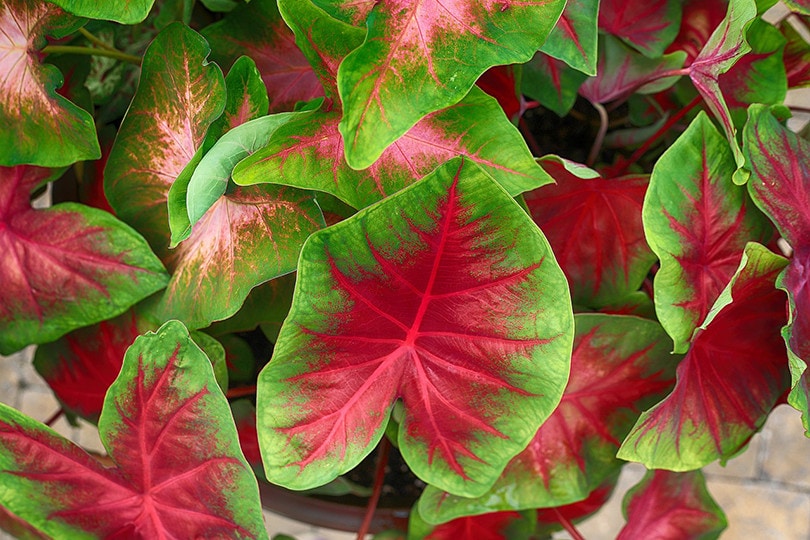Can Caladium Grow Indoors? Tips, Tricks, and How-to Guide
-
Shea Cummings
- Last updated:

Caladiums are beautiful tropical plants and their foliage is what really sets them apart. The big arrow or heart-shaped leaves are covered in different colors and patterns. Caladium foliage is covered in whites, greens, reds, and pinks. Their foliage is colorful enough that’s it’s not a big deal that they aren’t wild bloomers.
It’s possible to grow Caladium plants indoors, granted you can provide for their needs properly. Being tropical plants, they need adequate humidity and the proper lighting, and they are sensitive to temperature. In this article, we will go step-by-step through preparing your growing room for these plants and then offer a few helpful tips.
Preparing to Grow Caladium Indoors

Growing Caladium indoors can be a challenge because they are very sensitive to their surroundings. So, you have to mimic their tropical home as much as possible to enjoy these beautiful plants as long as possible. You can expect these plants to show off their amazing foliage for 6 months or longer with proper care.
1. Light
Even though the Caladium is a tropical plant, it doesn’t enjoy direct sunlight. A good rule of thumb to help you determine how much light your Caladium can take is to pay attention to the size of the leaves. Narrower leaves will take more direct sunlight. If you’re using planters, it’s easy to control the amount of light your plant gets by placing it in strategic places around your home. If you live in a suitable climate, you could even set it outside in the shade during the day.
2. Temperature
Caladium plants like it hot. Ideally, you want to keep the temperature somewhere in the neighborhood of 70–75 degrees during the day and 60–65 overnight. You’ll also want to pay careful attention to the humidity with the temperature. You’ll want to keep their environment as humid as possible. A humidity tray is an excellent way to increase the humidity around the plant without it becoming overly humid throughout the house. A simple way to do this is by filling a tray with small pebbles and water and then placing your Caladium planter on the tray.
3. Soil
You’ll be fine as long as you’re using high-quality planting soil. The biggest thing to remember is that you need to ensure that the soil drains well, so your plant doesn’t sit in excessive water. Once the Caladium is established, keep it watered. It will die quickly if it dries out. As a rule, keep the soil damp, and you shouldn’t have any problems.

Caladium Cultivars
There are many different cultivars to choose from. The color and design of the leaves are determined by which one you are growing. In North America, these different cultivars are often sold simply as Caladium plants. There are purchased by looks. This way, you can fit it into your garden design or have it blend with your interior decor.
That being said, there are a few popular cultivars that are common if you find a grower selling specific plants.
- Caladium’ Miss Muffet’: Space is often limited with outdoor growing, so this dwarf variety is a great option. It reaches around eight inches on average. It has pink-spotted, lime-green leaves.
- Caladium’ White Christmas’: This cultivar stands out with its arrow-shaped leaves have bunches of bright white patches. The intense contrast makes this a stand-out addition to your decor.
- Caladium’ Creamsicle’: If you’re looking for a robust growing variety, the ‘Creamsicle’ is a great option. Its dark green leaves have vibrant red marks contrasting the white veins in the leaf.
- Caladium’ Puppy Love’: This one is a new cultivar. It’s hardy and can handle full sun in some climates. Instead of green, its leaves are pink with green tips.
Overwintering Caladium

Unlike many other indoor foliage plants, Caladium dies down during the winter months and remains dormant regardless of the environment you provide for it. This is a primary reason why not every indoor gardener should go for Caladium—they are a lot of work and can still only be enjoyed part of the year.
If you’re not discouraged after a year with your Caladium plant, it’s easy to keep it until it blooms again in the spring. As it dies in the fall, allow the soil to dry. Then cut the withered leaves off. Store the tuber in the dark at around 65–70 degrees. When you re-pot it in the fresh soil in the spring, it will regrow. You can usually do this overwintering for several years before needing a new plant.
Related Read: Can Coleus Grow Indoors? Tips, Tricks, and How to Guide
Conclusion
As you can see, Caladium is not for first-time indoor gardeners. While it’s possible to do, it requires a decent amount of knowledge on creating the right environment for the plant to thrive. However, if you can pull together the right temperature, humidity, and light, Caladium plants make an incredible addition indoors and out. The tips provided above should give you a good idea of whether growing these plants is something you want to attempt.
Featured Image Credit: sarangib, Pixabay
Contents
